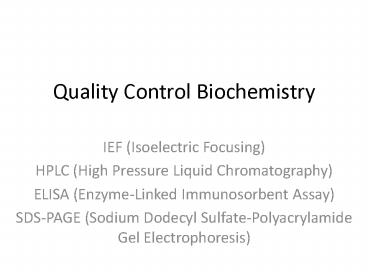Quality Control Biochemistry - PowerPoint PPT Presentation
1 / 23
Title:
Quality Control Biochemistry
Description:
Quality Control Biochemistry IEF (Isoelectric Focusing) HPLC (High Pressure Liquid Chromatography) ELISA (Enzyme-Linked Immunosorbent Assay) SDS-PAGE (Sodium Dodecyl ... – PowerPoint PPT presentation
Number of Views:917
Avg rating:3.0/5.0
Title: Quality Control Biochemistry
1
Quality Control Biochemistry
- IEF (Isoelectric Focusing)
- HPLC (High Pressure Liquid Chromatography)
- ELISA (Enzyme-Linked Immunosorbent Assay)
- SDS-PAGE (Sodium Dodecyl Sulfate-Polyacrylamide
Gel Electrophoresis)
2
Sampling
- Sample Environment
- Sample Water
- Sample Equipment
- Sample Process
- Samples processed in QC Microbiology (already
covered in Lecture One) and QC Biochemistry
3
Common Process Compounds and Methods of Removal
or Purification
Component Culture Harvest Level Final Product Level Conventional Method
Therapeutic Antibody 0.1-1.5 g/l 1-10 g/l UF/Cromatography
Isoforms Various Monomer Chromatography
Serum and host proteins 0.1-3.0 g/l lt 0.1-10 mg/l Chromatography
Cell debris and colloids 106/ml None MF (Depth Filtration)
Bacterial pathogens Various lt10-6/dose MF (Sterile Filtration)
Virus pathogens Various lt10-6/dose (12 LRV) virus filtration
DNA 1 mg/l 10 ng/dose Chromatography
Endotoxins Various lt0.25 EU/ml Chromatography
Lipids, surfactants 0-1 g/l lt0.1-10 mg/l Chromatography
Buffer Growth media Stability media UF
Extractables/leachables Various lt0.1-10 mg/l UF/ Chromatography
Purification reagents Various lt0.1-10mg/l UF
4
Test Total Protein via Spectrophotemetric
Absorption at 280nm
Tryphophan Phenylalanine Tyrosine ALL ABSORB
LIGHT AT 280 nm Crude, not necessarily
quantitative Same amount of protein will show
different A280 depending on amount of above amino
acids
5
Test Total Protein Bradford Assay
Coomassie Brilliant Blue G Dye and
Spectrophotometry at 595 and 450nm
6
ELISAs and PAGE
- ELISAs Use antibody reagents and a microtitre
plate reader to determine the concentration
and/or the activity of a protein of interest. - SDS-PAGE Use acrylamide gel electrophoresis to
separate proteins according to molecular weight
(a single band indicates purity if validated to
do so). - IEF (Isoelectric Focusing) Use an SDS-PAGE gel
box (or CE capillary electrophoresis) to
determine the pI or the pH at which the protein
of interest is neutral.
7
ELISAsAntibodies as Reagents
ELISAS are Immunoassays which use an antibody
(Ab) to detect and quantify substances Ab are
extremely specific ADVANTAGE Ab can not be
detected, need a marker Radioactive labels
(RIA) Enzymes (EIA) Horseradish Peroxidase or
Alkaline Phosphatase Fluorescent Tag
(FIA) Chemiluminescencent Tag
8
ELISAs
- There are several types of ELISAs including
direct (sandwich), indirect, competitive and
activity ELISAs. ELISAs are read on a microtitre
plate reader which is a mini-spectrophotometer
that determines the absorption or transmission of
a beam of light of a particular wave length
passing through a solution of the protein of
interest. Using standards to generate a standard
curve, one can determine the concentration of the
protein of interest in a sample.
9
HSA Direct ELISA ResultsSpring 2009 Data
Concentration ng/ml OD
0 0.071
6.25 0.169
25 0.426
100 0.951
400 1.156
Sample 1 1.320
Sample 2 1.290
Sample 3 1.290
10
ELISA Equipment
- Multi-Channel Pipettor
- Microtitre Plate Reader
11
ELISA Process
- To make an ELISA, one must utilize antibodies to
the protein of interest. The first antibody
recognizes the protein of interest. The second
antibody recognizes another epitope on the
protein of interest and carries a signal (or
enzyme) that will be used to quantify the protein
of interest.
12
Direct ELISA Antibody Sandwich
13
Direct and Indirect ELISA Animation
- usmlemd.wordpress.com/2007/06/12/elisa-test/
14
Acrylamide Gel Electrophoresis
Sodium Dodecyl Sulfate-Polyacrylamide Gel
Electrophoresis SDS-PAGE demonstrates proteins
in a sample separates proteins based on molecular
weight quantify proteins by densitometry step in
Western blot used to identify protein Isoelectric
Focusing IEF identifies the pH at which a
protein carries no net charge used to develop
chromatographic separation protocols/SOPs Devel
oped by Laemmli in 1970
15
SDS-PAGE
- SDS-PAGE Gel Box
- SDS-PAGE Overview
- SDS Polyacrylamide gels (SDS-PAGE) are called
denaturing gels because they contain sodium
dodecyl sulfate (SDS), an ionic detergent that
binds to the amino acid residues in the proteins.
Due to its ionic properties, SDS confers a net
negative charge on all the proteins, overcoming
any intrinsic charge in this way the proteins
uniformly migrate toward the positive electrode.
SDS also disrupts the secondary and tertiary
structure of the proteins, essentially destroying
their globular configuration and making them into
linear molecules that then migrate in the
electric field on the basis of their size. PAGE
is a very powerful technique because even small
differences in molecular weights produce
distinguishable bands on a gel.
16
SDS-PAGE
- detect proteins using Coomassie Blue Stain
- characterize (MW)
- quantify (densitometry)
- determine other proteins in a sample (purity)
- step in Western blot (used to identify)
17
Molecular Weight DeterminationSDS-PAGE
- Run SDS PAGE with known standards (MW markers)
- Graph distance from wells to bands to make
standard curve - Measure distance from well unknown protein
traveled - Compare on standard curve to determine MW of
unknown
18
IdentificationImmunoblot (Western) from PAGE
19
Identification and Quantification HPLC
High Pressure Liquid Chromatography (HPLC) uses
the same components and processes as LPLC HPLC
uses small samples injected with high pressure.
20
QC Biochemistry Additional Techniques to
Determine Purity, Molecular Weight, Function and
1o, 2o, 3o, 4o Structure
- 2D Gel Electrophoresis
- Capillary Eletrophoresis
- Analytical Ultracentrifugation
- Mass Sepctrometry
- Fluorescence Spectroscopy
- Amino Acid Sequencing
- X-ray Crystallography
- Nuclear Magnetic Resonance
- PCR (used in QC Microbiology)
21
Small QC Laboratory in Production Area of a
Biomanufacturing Facility
Biological Safety Cabinets (BSCs)
Pass Through for Samples
22
Small QC Laboratory in Production Area of a
Biomanufacturing Facility
Nova Analyate Analyzer
Centrifuge
23
Small QC Laboratory in Production Area of a
Biomanufacturing Facility
Micropipettor Set
Compound Microscope































